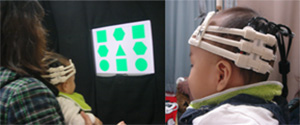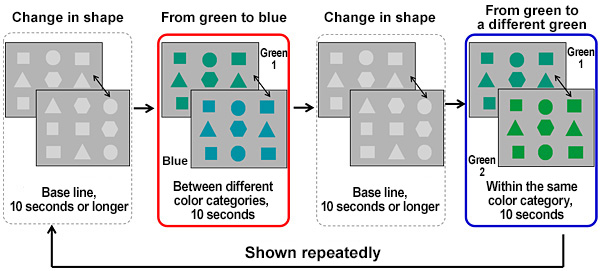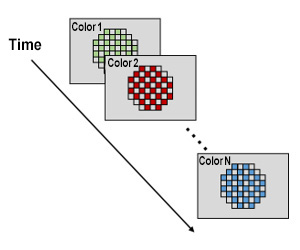2019.11.13
Examining the World of Colors as Seen by Infants

- Jiale Yang
- Institute Assistant Professor, Research and Development Initiative, Chuo University
Areas of Specialization: Experimental Psychology and Developmental Psychology
Special feature for commemorating the
20th anniversary of establishment of
Research and Development Initiative,
Chuo University

This year, Research and Development Initiative, Chuo University commemorates the 20th anniversary of establishment. Since it was established in July 1999, it has been tackling problems with the actual society, for the purpose of developing a sustainable society, as a research center with the mission to achieve collaboration among industry, government, and academia and deepen exchanges for research. Over the past two decades, more than 100 research units have been organized, and many research outcomes that are influential academically and socially have been produced thanks to the efforts of a lot of participating researchers.
This special feature is focused on researchers participating in ongoing research units, and describes their research activities, to introduce some of research outcomes at Research and Development Initiative.
Our group has conducted various studies on the development of color perception in infants. The world in which we live is filled with colors. From the blue sky to red apples and green forests, colors are found in everything around us. Therefore, we use colors to recognize, distinguish, and select things. In addition to providing us with information about things, color also cultivates our sensibilities in areas such as painting, interior design, and cosmetics. So, how do we begin to perceive colors? Can a newborn baby see colors?
Do babies perceive color categorically?
Adults possess categorical color perception in which we perceive multiple slightly different colors as a single category. For example, some greens are bluish greens and some are yellowish greens. However, even if each green has slightly different shade, we recognize multiple greens as belonging to the same category. Recent researches on adult humans and monkeys have shown that part of the posterior temporal cortex contributes to the processing of color categories. The color categories perceived by adults are primarily associated with color terms in the language being used. Consequently, categorical color perception is considered to be closely depended on language and culture. In particular, the Sapir-Whorf hypothesis, which is a famous hypothesis in psychology, linguistics, and cultural anthropology, postulates that perceptions and thoughts are influenced by language. Therefore, many psychologists think that color categories are determined by culture and language.
However, our research group (Institute Assistant Professor, Jiale Yang, Research and Development Initiative, Chuo University; Professor So Kanazawa, Japan Women’s University; Professor Masami K Yamaguchi, Chuo University; and Associate Professor Ichiro Kuriki, Research Institute of Electrical Communication, Tohoku University) was the first in the world to find a proof that color categories are independent of culture and language. In other words, we found evidence that color information is processed categorically in the brain even by infants who do not understand language.

Figure 1. Scenes from the NIRS experiment. Left: An infant with NIRS probes watching an image changing between two colors. From the NIRS probes, we record changes in cerebral blood flow when viewing images. Right: Measuring the infant’s posterior temporal region, which is the area that processes color category information in adults.
In our experiments, we used near infrared spectroscopy (NIRS)*1 for infants aged 5-7 months (an age prior to language acquisition) to determine whether there was any cortical response related to categorical color perception. NIRS was used to measure the cerebral blood flow response in the posterior temporal region when an infant observed a series of geometric figures that changed in two colors within the same category (i.e. Green 1 and Green 2) or changed in two colors cross the boundary of color category (i.e. Green 1 and Blue; Figure 2). The point of this experiment is that the color difference between Green 1/Green 2 changing in the same color category and Green 2/Blue in different color categories is the same. (Color difference is the distances of two colors within a quantified color space. Large color differences are easy to distinguish and smaller color differences are difficult to distinguish.)
If the brain reacts only to color difference, the same brain activity should be observed regardless of whether the change is within the same color category or between different color categories. The posterior temporal region is the area of the brain that processes color category information in adults. In our experiment, stronger brain activity was confirmed when participants observed color changes between different color categories compared to color changes within the same categories. Similar cerebral blood flow responses were also observed in adults who have acquired language. These results prove that brain processing related to categorical color perception exists before language acquisition, and that categorical color perception is independent of the language system. These research results raise important points for discussing the Sapir-Whorf hypothesis and were published in Proceedings of the National Academy of Sciences in 2016. Due to the significant impact of the results, our research was featured in many reports by domestic and overseas organizations, including the world’s oldest general scientific journal Scientific American.

Figure 2. Flow of experiment. The experiment image was repeatedly shown in the order of “base line → change between different color categories → base line → change within the same category” until the infant lost interest and stopped watching. For the change between different color categories, the color of the image changed between the green and blue categories. For the change within the same category, the color of the image changed between Green 1 and Green 2. For the base line, the shape changed but the color remained the same.
As shown by our research, in addition to providing developmental knowledge regarding the manifestation of abilities, developmental psychological research dealing with infants also contributes to significant knowledge in the field of general psychology. In particular, research on infants is indispensable in research fields deemed as closely related to language and culture. In other words, the relationship between certain abilities and language/culture can be clarified through research on infants who have not acquired language and are not influenced by culture.
How are colors processed in an infant’s visual cortex?
Brain research on Macaque monkeys has revealed that the visual cortex which processes visual information has many neurons responding only to specific colors (so-called hues; for example, red, green, yellow, blue, orange, purple and pink). Several research studies on brain function imaging in adult humans have also reported that the visual cortex may have many neurons which process each hue independently. The property in which one neuron responds to only one hue is called hue selectivity.
On the other hand, researches based on the behavior of infants hypothesizes that infants are able to distinguish between red and green at about two months of age, and between blue and yellow at about four months of age. The question is, from when does the development for hue selectivity of the visual cortex including intermediate colors (purple, orange, pink, etc.) start? Our group is currently conducting research to clarify this issue with the support of the JSPS Grant-in-Aid for Scientific Research.

Figure 3. Images shown to infants in the SSVEP experiment. The color of the checkerboard pattern changes every second in conjunction with the hue circle.
The experiment use steady-state visually evoked potentials (SSVEP)*2 that can be easily measured even for infants. A hue circle arranged in the order of “red → orange → yellow → green → blue → indigo → purple” is divided into 12 equal parts, and the corresponding 12 colors are selected and tested. Checkerboard patterns using each of the different hues were shown to infants aged 5 to 6 months (Figure 3), and the SSVEP amplitude when observing the checkerboard pattern of a different hue is compared. By comparing the amplitude of SSVEP induced by the stimuli of different hues, we are investigating the sensitivity of the visual cortex to different hues. We are currently conducting experiments and working to confirm the possibility that even infants in the early stage of development possess the same hue selectivity (including intermediate colors) as adults do. By comparing adults with infants who are not affected by language or culture, this research examines the extent to which color information processing in the visual cortex is affected by higher-order factors such as living environment and language. This enables us to contribute to solving a traditional controversy in developmental sciences—namely, “nature or nurture.”
The SSVEP measurement method used in this research has the advantage of a higher signal-to-noise ratio than other (electroencephalography) EEG measurement methods, so numerous colors can be tested in a short time. If this research succeeds in measuring the hue selectivity of the visual cortex, the same technique can be applied to other research on the development of color vision. As a result, we expect significant advancement in this research area. Furthermore, by using the method proposed in this research, we believe that it will be possible to conduct detailed investigation of all color category boundaries even when studying a smaller number of people.
- Near infrared spectroscopy (NIRS): A non-invasive brain function imaging method that uses near-infrared light (wavelength of 700 nm to 1,300 nm) to easily penetrates living cells. In this method, the head is externally irradiated using a near-infrared laser beam. After scattering and absorption are repeated in the cerebral cortex, the amount of light returning to the scalp is analyzed. Since the absorption characteristics of infrared light change depending on whether or not hemoglobin in the blood has oxygen, it is possible to measure relative changes in oxygenated hemoglobin, deoxygenated hemoglobin, and total hemoglobin at the surface area of the brain cortex. Furthermore, since oxygen is consumed with the activity of nerve cells, the brain activity in the light transmission path can be estimated by measuring the oxygenated/deoxygenated hemoglobin.
- Steady-state visually evoked potentials (SSVEP): The electric potential of the evoked electroencephalogram component that has the same frequency as the flicker stimulus when observing periodically flickering stimuli.
Jiale Yang
Institute Assistant Professor, Research and Development Initiative, Chuo University
Areas of Specialization: Experimental Psychology and Developmental Psychology
Jiale Yang was born in Guangdong Province, People’s Republic of China.
In 2004, he graduated from the Department of Applied Psychology, Jilin University, People’s Republic of China.
In 2009, he completed the Master’s Program in psychology course in Chuo University Graduate School.
In 2012, he completed the Doctoral Program in psychology course of the same graduate school. He holds a Ph.D. in psychology.
Prior to assuming his current position in 2019, he served as research assistant at Chuo University, research fellow for young scientists (DC) at the Japan Society for the Promotion of Science, researcher at Japan Women’s University, special researcher in the Graduate School of Arts and Sciences, the University of Tokyo, postdoctoral fellow (PD) at the Japan Society for the Promotion of Science, and visiting researcher at Goldsmiths, University of London.
He currently conducts research on the development of color perception, material perception, and body perception in infants.
